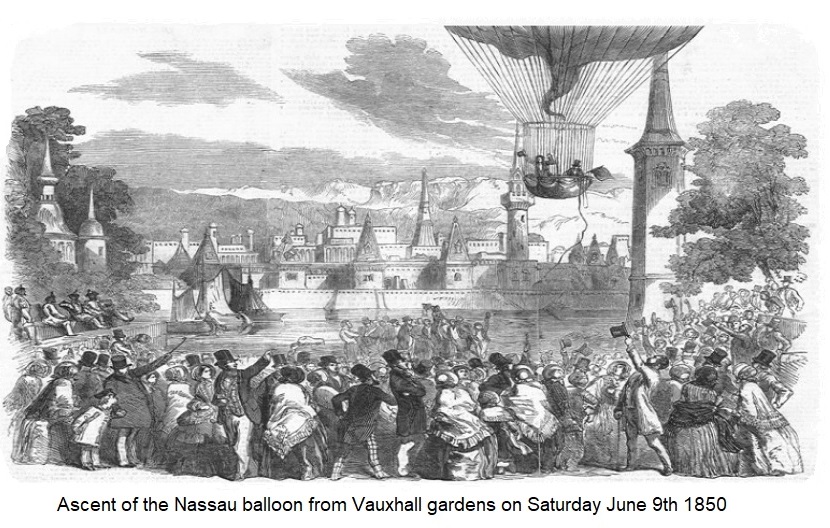The dream of being able to fly through the air like a bird, has perplexed many generations through the ages. Various designs like those of Leonardo da Vinci were drawn or small models made, but it was not until the end of the Eighteenth Century in France that man took the first tentative steps in a form of transport that these days we all take for granted.
Now, some fifty years after the Montgolfier brothers took to the skies in a hot air balloon Robert Hollond and some of his chums from the balloon aeronautical society decided they were going to set a record distance ballooning attempt and fly from from The Vauxhall Gardens in Kennington, to the town of Weilburg in Germany.
It all stared with a young man with an interest in flying named Charles Green. Charles was fast becoming a known face in the Ballooning world, and regularly held aeronautical entertainment shows around London. Ballooning was not yet seen as a viable mode of transport but the public were warming to it, and the shows were becoming more popular, so Green was on the lookout for a larger venue. Then in the summer of 1836, he found the ideal location, The Royal Gardens Vauxhall.
Under his guidance the gardens operators Messrs Gye & Hughes, financed the building of a huge balloon, 80-foot-tall and over fifty-foot-wide. Built to Greens specific specifications, it included a couple of prototype modifications, these included Greens invention of a 1,000 foot ’guide rope’ with specifically designed copper floats to relieve the balloon of part of its weight as it trailed along near the ground. Another of Greens ideas was to take numerous small parachutes for dropping communications and fireworks in case of a landing in the dark, but Green’s most significant alteration, was its lifting agent.
Up until now most balloons took off using a mixture of hot air and hydrogen, but hydrogen was very expensive so Green experimented with the use with coal gas. This was lot cheaper but had less lifting power hence the reason the balloon had to be built to this colossal size, and not just to lift the balloon into the air but also to carry the passengers. Green was already streets ahead with his ideas of balloon travel and toyed with the notions of long distance flights. The balloon would then not only have to carry the passengers but, their luggage, extra provisions of food and drink in case they were blown off course, a ton of ballast and scientific apparatus for use over the journey. The size of their new balloon suited the owners of the gardens as their new attraction when airborne, could be seen from miles around.
Construction of the new balloon cost over £2000, which today would be well over £100,000, the silk alone costing over £700. The contract to make the silk was given to a company in Spitalfields, its historic association with the silk industry producing some of the best material in the country, and it was coated with a special varnish to prevent the escape of gas. What a magnificent spectacle it must have been, decorated by white and crimson gores placed between the gondolas support ropes. The gondola itself decorated by purple velvet with a large golden eagle’s head at either end of the basket.
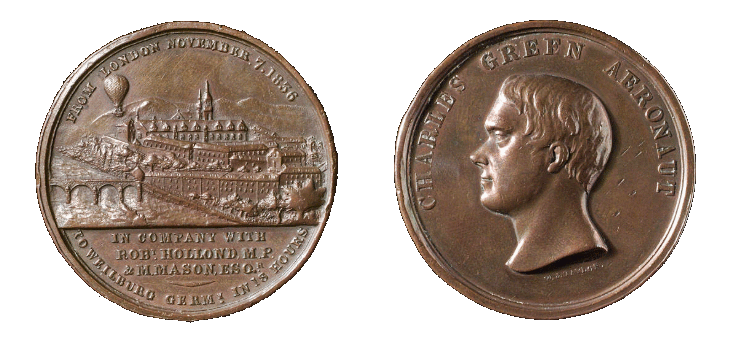
The new balloon handled well and Green spoke to the owners about a flight he was planning, to cross the channel to Germany. The proprietors were more than happy to rent their new attraction for the event, what an advert. So Green set about recruiting a couple of fellow adventures. There was the Irish writer, musician and keen balloonist Thomas Monck Mason, who was to write a record of the journey, and the expedition’s backer, our very own Robert Hollond. The whole project was bankrolled by Hollond, he hired the balloon from the proprietors at Vauxhall and he paid for the necessary supplies and preparations. Bearing in mind that the journey would only be over two days they had a staggering amount of food, enough to last for a couple of weeks, and it was only the best for our three adventurers. Included were over 80 lbs of cooked meats including twelve fowls, two four-gallon kegs of water and six gallons of spirits, including sherry, port, and brandy stored in wine jars and spirit flasks. What a party that must have been, and for the morning after there was even a coffee-machine.
With everything in place, it was decided that if they were blown off course, they needed documentation to prove who they were and not some advance invasion force or foreign foe. They were issued with passports from the Dutch and French Embassies, and had a signed letter for the King of Holland from the Dutch Consul. The original passport signed by Robert Hollond is held in the National Aerospace Library at Farnborough Written in French it is translated as follows:-
With Authorisation of his Majesty the King of Netherlands, Prince of Orange, Duchy of Luxembourg, and so on, the undersigned General Consul of his Majesty in Great Britain and Knight of the Order of the Lion, respectfully requests from civil and military officers, to allow Mister Charles Green, English Aeronaut, accompanied by Mister Holland and Mister Mason, to freely journey from England, London, to Netherlands by balloon, and to provide support and protection if needed. Valid for 6 months, written in London the 2nd of November 1836, The General Consul, General Consulat of Netherlands in London”.
A journey into the record books
Then on 7 November 1836 the day had come. The event wasn’t advertised as no one was really sure what would happen or even if the feat was achievable but one thing was for sure, Charles Green could always pull a crowd and with his new super-sized balloon, the park was filled with spectators for this epic event.
At 1:30 pm precisely the Royal Vauxhall balloon started to rise to great cheers from the crowd. It set off heading towards Dover and then across the Channel. The bottom of the basket had been cushioned in case any of the lads fancied getting some sleep during the night, but as they were carrying so many provisions there wasn’t a great deal of space, so they took it in turns to cat nap while at least one of the group stayed awake to keep lookout. To stave off boredom one little pastime that amused them was to fly low over farmlands and drop fireworks attached to the small parachutes that they carried, startling the farm labourers toiling in the fields below. Just before morning they encountered the ground covered in snow. Worried they may have gone astray and entered Poland or greater Russia they decided the best option was to stop and ask where they were. All had gone to plan and they had arrived in Duchy of Nassau in Germany only a few miles from their intended destination. So, after a short hop the balloon was landed at 7.30 am the next day near the town of Weilburg, in the County of Nassau.
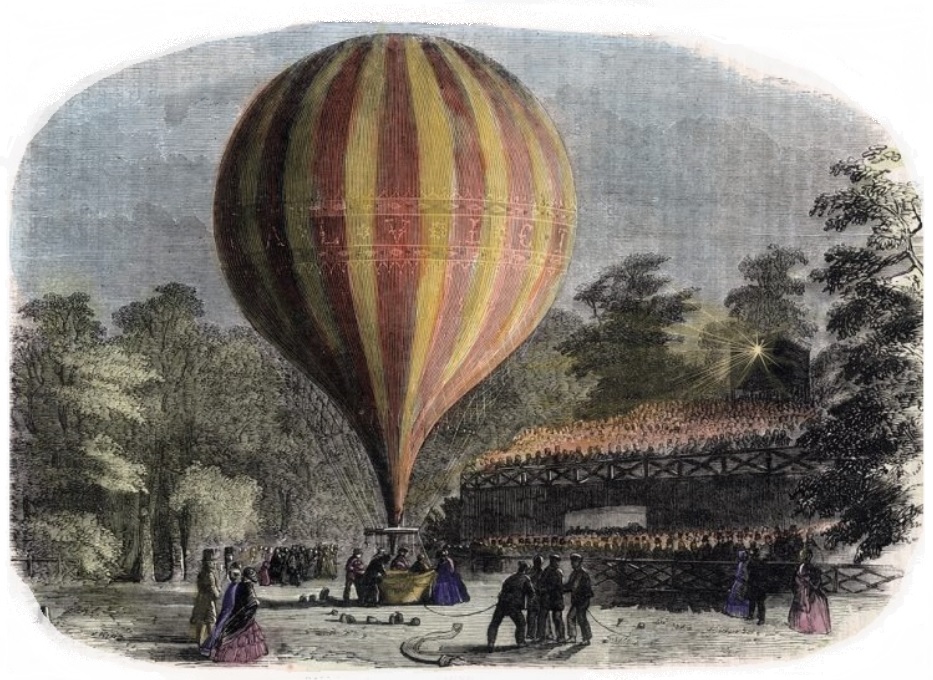
World Ballooning record
They had made it, the 480 mile flight was achieved in 18 hours, this is the longest man had accomplished up untill this time. The flight set world distance record for manned flight that would hold for eight-decades and would not be beaten until 1914 when the German, Karl Ingold beat it in his Mercedes-powered Aviatik biplane.
The three aeronaughts were treated as heroes by the local population and dignitaries of Weilberg, one commenting ”we experienced the kindest reception from the Prince and people of Nassau”.
For two weeks the lads were guests of the Prince of Nassau and a great time was had by all, and undoubtly the distribution to the local wellwishers of the huge quantity of spirits on board must have helped. The three were treated to a number of swanky public events in their honour one of the biggest was the balloon being formally rechristened ’The Great Balloon of Nassau’ in a civic ceremony held before the day of its departure back to England. A second naming ceremony was later held on 10 July 1838 in Vauxhall where it was recristened, the ’Royal Nassau Balloon’ in honour of the backing from the Duke of Nassau, a special ’Duke of Nassau’s Day’ was put together, unfortunaly the poor old Duke had sustained an injury after falling from his horse and ended up missing the event.
Then it was time to come home, but they had one big problem, the balloon was converted to fly using coal gas, unfortunaly this commodity wasn’t produced in Nassau, so the return journey had to be made by carrage. En route to London they stopped in France for Christmas, the news of the balloon had travelled before them and a small event was put together in the barracks in the Rue Faubourg-Poissonnièr. Seats were sold to the lucky few, for the joy of taking a ride in the record-breaking balloon. On 9 January 1837 the balloon rose three times, each time with a gondolier containing ten passengers.
In March 1837 The landscape artist William Turner, wrote the following to Robert Hollond, with a view to capture some of the scenes of the flight on canvas:- “Your Excursion so occupied my mind that I dreamt of it, and I do hope you will hold to your intention of making the drawing, with all the forms and colours of your recollection”. Nothing came of it and eventually a local illustrator Edward William Cocks was commissioned, he painted six commemorative pictures covering the flight.
Other commemorative articles included a small batch of bronze medals, with Charles Greens head on one side and a view of Weilburg on the other,and the inscription ’From London November 7 1836 to Weilburg Germany in 18 hours in company with Robert Hollond MP and M. Mason esq’. The local church in Nassau commissioned, and still has, a stained-glass panel celebrating the occasion. But quite possibly the most impressive commemorative piece was a painting entitled ’A Consultation Previous to An Aerial Voyage from London to Weilburg in Nassau’. Robert Hollond commissioned the painting from his friend John Hollins. Hollins even manages a cameo in the painting standing at the rear between Walter Prideaux and Sir William Milbourne James.
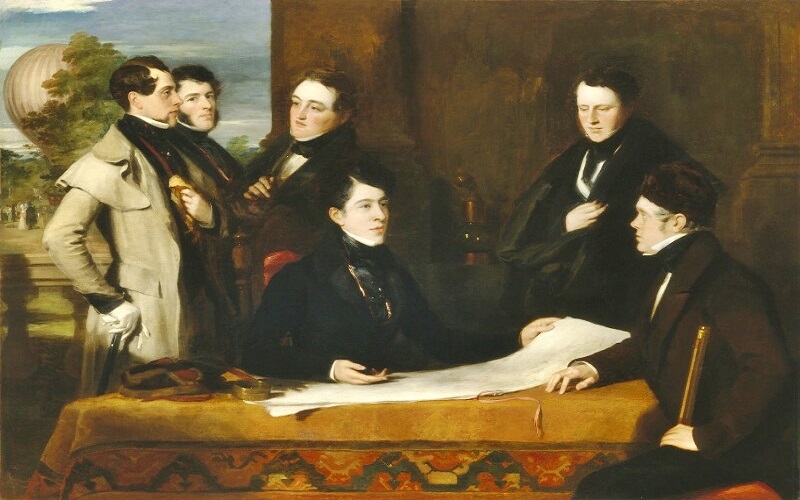
The work shows the three adventurers seated around a map laid out on a table devising a flight plan for the journey. From left to right, Walter Prideaux lawyer and poet, John Hollins the artist, Sir William Milbourne James, another lawyer and later lord justice, our very own Robert Hollond, Thomas Monck Mason, the author of Aeronautica and last but not least Charles Green. Prideaux and James were well connected lawyer friends of Robert Hollond, and lent a hand in obtaining or drafting the necessary paperwork for the voyage, hence their inclusion in the portrait. In the background is the famous balloon, and props used in the painting were actual artefacts from the journey including the lantern, a fur hat and compass placed on the table and a telescope held by Charles Green The painting was originally sold for the princely sum of two guineas, and is now held in the National Portrait Gallery, London.
In many ways the record-breaking balloon run was not supposed to be a public spectacle, but after they achieved the impossible word spread like wildfire and everyone wanted part of the action. The Vauxhall owners of the balloon were of course more than happy to cash in on the event, and employed the services of Charles Green to pull in the crowds. Tickets went for a whopping £21 for gentlemen around £1,000 in today’s money and £10 10s. for ladies. Green himself was paid nearly £1000 in the first-year 1837, and total revenue kept the gardens in profit where other pleasure parks of the day was struggling. The owners of the park built a huge motorised panoramic back drop of the flight. The scene painted on a moving canvas roll measured nearly 80,000 feet and depicted the voyage from Vauxhall, over the Channel, across France, Germany and the descent near Weilburg. Before the days of TV this was real entertainment and certainly drew in the crowds of the day.
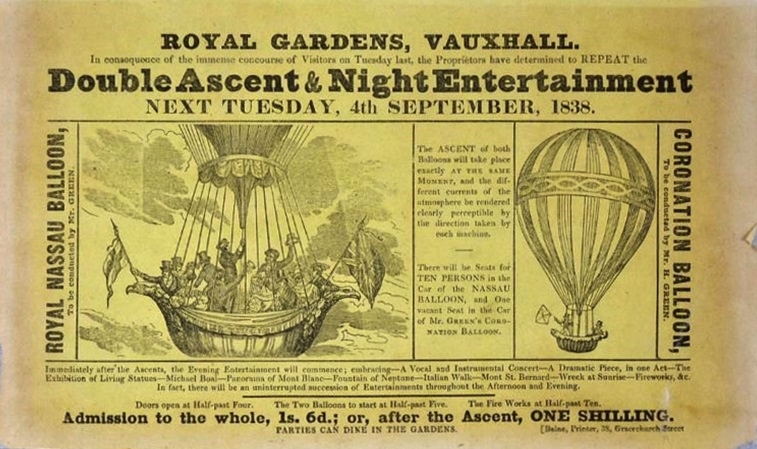
And what became of our three heroes, well, as quickly as it started it was all over, the three went back to their respective jobs. Green stayed with ballooning and furthered his career bringing his wife Martha and brother into the family business and eventually recording over 500 flights. He went on to set further records for both distance and height and speed recording 480 miles 27,000 feet and 80mph respectively. He died on 26 March 1870 at Arial Villa his home in Holloway, he was 85. In his honour the ’British Balloon and Airship Club’ named trophy after him named the Charles Green Salver, and was decorated with an engraving of the Vauxhall Nassau Balloon. Included in the recipients of the salver have included Richard Branson in 1988, for the first crossing of the Atlantic by hot-air balloon.
Soon after the flight Thomas Mason wrote an account of the voyage, which he followed up by a more detailed account of the journey which he dedicated to his friend Robert Hollond, published in 1836 he imaginatively entitled it an ’Account of the Late Aeronautical Expedition from London to Weilburg.’ A prolific writer he produced many books covering a plethora of subjects. An accomplished singer and musician he also made a good living from his musical work, although lost the lot when a deal involving renting London theatres to stage opera, went tragically wrong. The court case over the losses was to drag on for over two decades. Mason died in 1889.
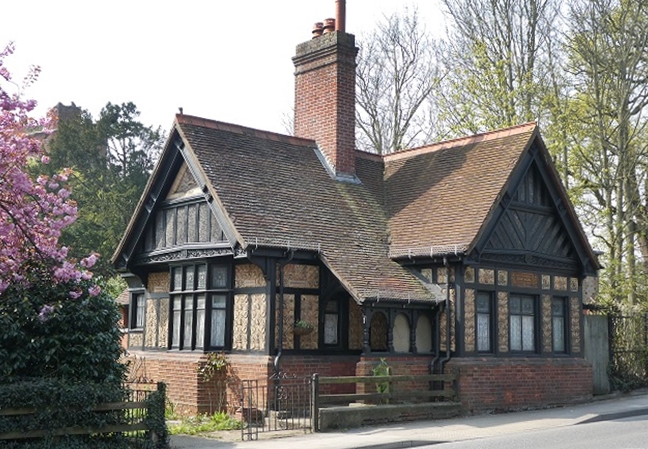
‘Erected in loving memory of Robert Hollond by Ellen Julia his widow 1881'
The following year after the flight Robert Hollond took up his position in the House of Commons. Hollond served as a Whig politician representing the constituency of Hastings, where he served until 1852. Hollond married Ellen Teed and in 1847 bought Stanmore Hall. The house and surrounding land had previously belonged to his father-in-law, Thomas Teed, when it was known as The Dower House estate. Robert and Ellen lived there all their lives and were buried in the Hollond mausoleum in the old brick church
He is remembered locally by Hollond Lodge, sometimes known as Church lodge which was built by Ellen as a memorial to her husband in 1881. She employed the Ipswich architect Brightwen Binyon for the job and he created this wonderful building very much in the Arts and Crafts Revivalist style. Now grade II listed, it is built in red brick, terracotta and timber. Fish scale decoration on the roof, decorative glass and ornamental barge boards. the inscription over central window reads:-
’Erected in loving memory of Robert Hollond by Ellen Julia his widow 1881’
The moulded panel at the apex has an armorial crest and the motto VINCIT QUI SE VINCIT. "He conquers who conquers himself." A very apt motto for the life of Robert Hollond. The property as well as being highly picturesque was once used to house the parish clerk. Robert Hollond is also commemorated in a window on the south side of the present church of St. John the Evengelist.
On 17 July 1840 Charles Green bought the balloon itself from the Vauxhall proprietors for £500 at auction, from 1854 ballooning ceased to become such an attraction at the park it went on tour across the country at different events The Nassau balloon was eventually sold to Henry Coxwell, one of Green’s younger competitors, who continued using it until 1873, with some reconditioning. Eventually the inevitable happened and the Great Royal Nassau Balloon just became worn out and started to perish after almost 40 glorious years of use, and was eventually scrapped.
This one flight helped to turn the publics opinion that contrary to reports at the time that passengers would suffer from altitude related problems, balloons became safer and easier to control, and largely thanks to Charles Green it helped turn this from a middle-class eccentricity to the accepted and professional sport that it is today.
